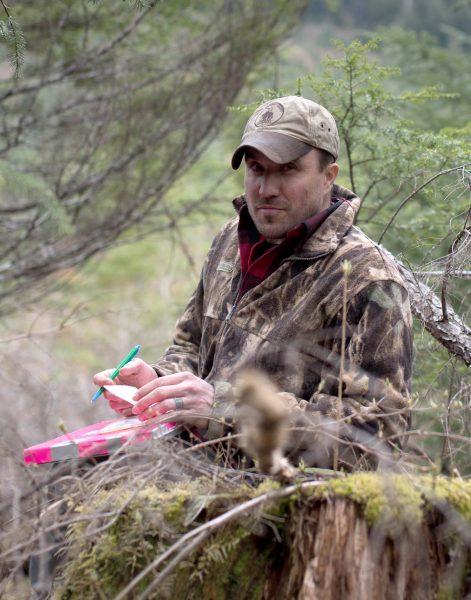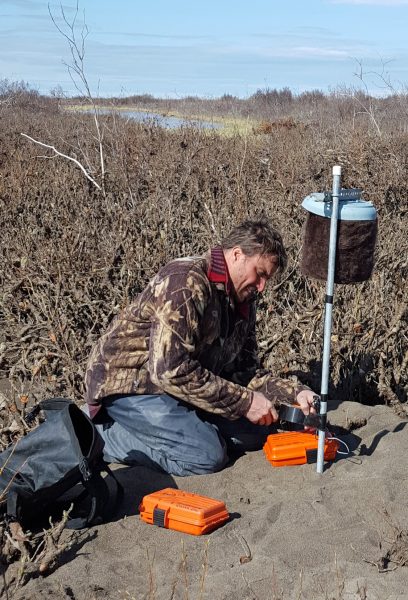Brinkman seeks connections between people, wildlife
May 22, 2017
Tom Moran
907-474-5581

Download text and photo captions here.
There are a lot of ways to gather information about remote Alaska, including satellites, drones and helicoptering in to take field measurements. But Todd Brinkman also includes another approach: talking to the people who live there.
“I think working closely with communities results in stronger science,” said Brinkman, a University of Alaska Fairbanks assistant professor of wildlife ecology. “One of the main reasons I feel this way is they bring a very unique perspective to the conversation. They also are spending a lot of time out in the environment, interacting with the wildlife, and seeing some of these changes that we’re not going to see from our offices here at the university.”
Brinkman’s interest in involving local residents in framing and interpreting his research makes a lot of sense considering his scientific focus, which is on interactions between humans and wildlife. Brinkman estimates he is currently working on eight different projects, most of which in some way touch on the intersection between ecology and social science.
“In the field of wildlife management, we’ve largely ignored the human dimension, we’ve tried to look at these systems while isolating humans from them,” he said. “But I think that’s inappropriate because humans are influencing every natural system I can think of right now.”
Brinkman recently applied his research approach to the North Slope village of Nuiqsut, where he supplied subsistence hunters and fishers with camera-equipped GPS devices and asked them to take photos of environmental and social changes. The result was a database of more than 200 geotagged pictures and accompanying data documenting river erosion, wildlife locations, landscape changes from oil development, and even cultural events.
“It helped us understand what the community’s thinking about,” Brinkman noted. “It helped us better identify scientific research that we could conduct that would be of value to that area.”
The hunters’ observations and comments led Brinkman and UAF biology graduate student Taylor Stinchcomb to launch a project to track the noise generated by aircraft around Nuiqsut hunting areas, and to study how it might affect the patterns of subsistence animals and hunters. Brinkman and Stinchcomb set up field microphones in 2015 and 2016, and were able to gather full data from 13 units during almost 90 days of recording. Brinkman said Stinchcomb is in the process of analyzing the results, which will be presented back to the Nuiqsut community and also shared with agencies.
“This has been a problem for 30 years, and there’s really been no effective way to address it, so we’re just trying to get some baseline information on where and when this aircraft traffic is occurring, to maybe advance the discussion a little bit,” Brinkman said.

Brinkman first came to UAF as a doctoral student in 2003 after receiving a bachelor’s degree in biology and environmental science at Minnesota State University and a master’s degree in wildlife science at South Dakota State University. He was hired as tenure-track faculty member at the Institute of Arctic Biology in 2014 through the Alaska EPSCoR program. He works as a key faculty member in EPSCoR’s Northern Test Case, which focuses on the ways Arctic villagers are responding to environmental change and burgeoning oil and gas development.
But the Arctic is just a small part of Brinkman’s research focus. His projects are varied — refining a technique for locating polar bear dens, examining the impacts of Southeast Alaska logging on deer habitat, and studying the impacts of climate change on traditional harvests in Interior and Western Alaska communities. He’s also engaged in a NASA project that resembles his work in Nuiqsut but which focuses on the ways that climate change affects access to subsistence resources in Interior villages.
When asked to find the common threads in his projects, Brinkman can point to a few: large mammals, integrating the human dimension into ecological research, and also the fact that most of his research addresses contentious management issues. He says that’s a deliberate choice.
“Even though it’s being contentious can make for an uncomfortable work environment sometimes, the reason it’s contentious is because it’s important to people,” he said. “So you’re working on something that seems to matter.”


